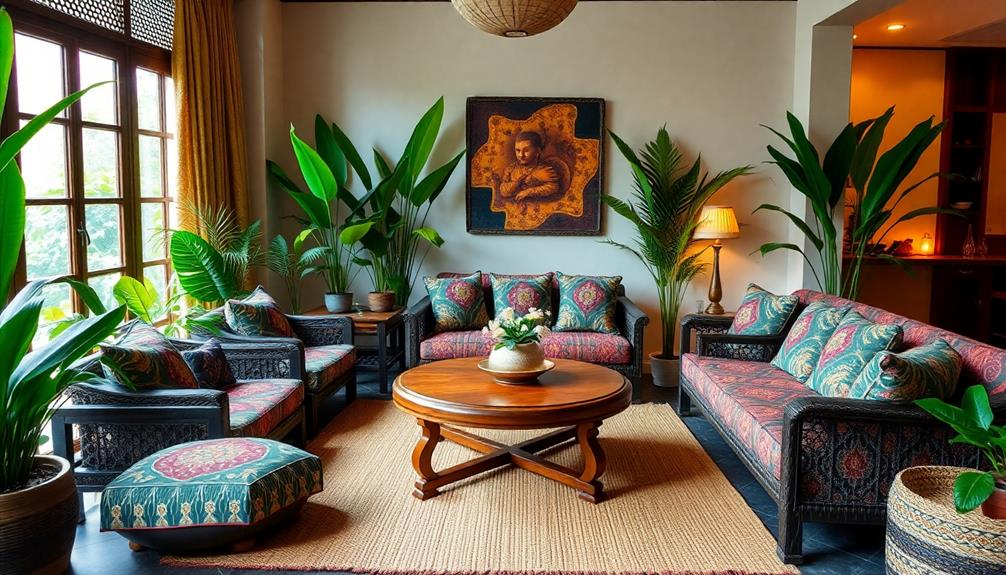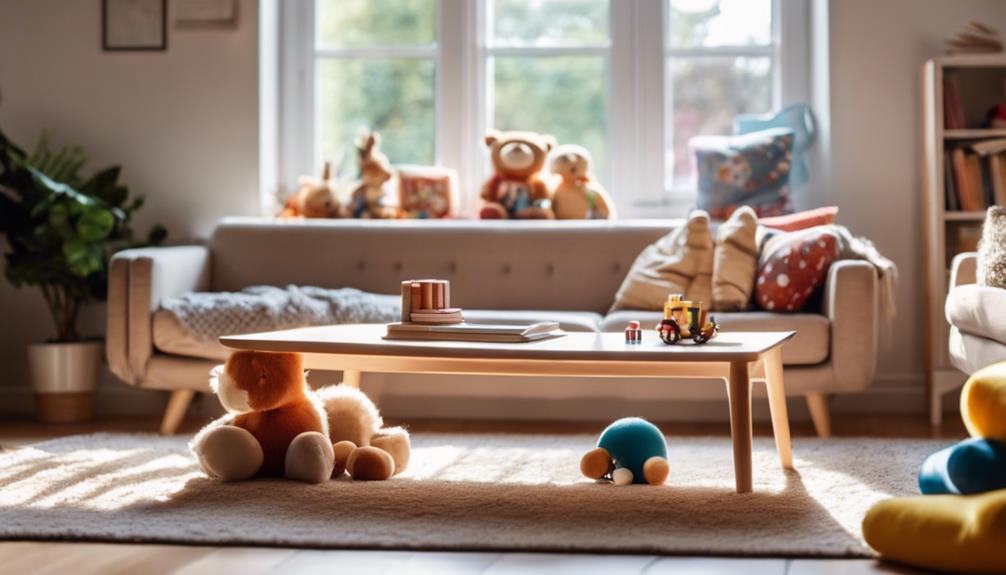You'll find that modern spaces beautifully embrace traditional Indonesian patterns, particularly batik, which showcases intricate designs steeped in cultural heritage. This art form enhances both fashion and interiors, merging rich history with contemporary aesthetics. You can integrate batik into your home through upholstery, wall art, or decorative cushions, all of which add vibrant texture and a sense of heritage. Additionally, fashion designers are creatively incorporating batik into unique clothing, celebrating artisanal craftsmanship. Exploring how this blend of tradition and modernity unfolds can inspire your own design choices and deepen your appreciation for Indonesian culture.
Key Takeaways
- Batik textiles can enhance modern interiors through upholstery, curtains, and decorative items, creating a unique blend of tradition and contemporary design.
- Integrating batik patterns into fashion revitalizes traditional craftsmanship while catering to modern aesthetic sensibilities and consumer demand for uniqueness.
- The use of batik in home decor celebrates Indonesia's cultural heritage, offering vibrant colors and intricate designs that complement modern spaces.
- Workshops and community initiatives help preserve batik-making skills, ensuring the future of this traditional craft while promoting sustainability and local economies.
- Events like "Batik Kita" inspire contemporary interpretations of batik, bridging historical artistry with modern fashion trends and design collaborations.
The Essence of Batik
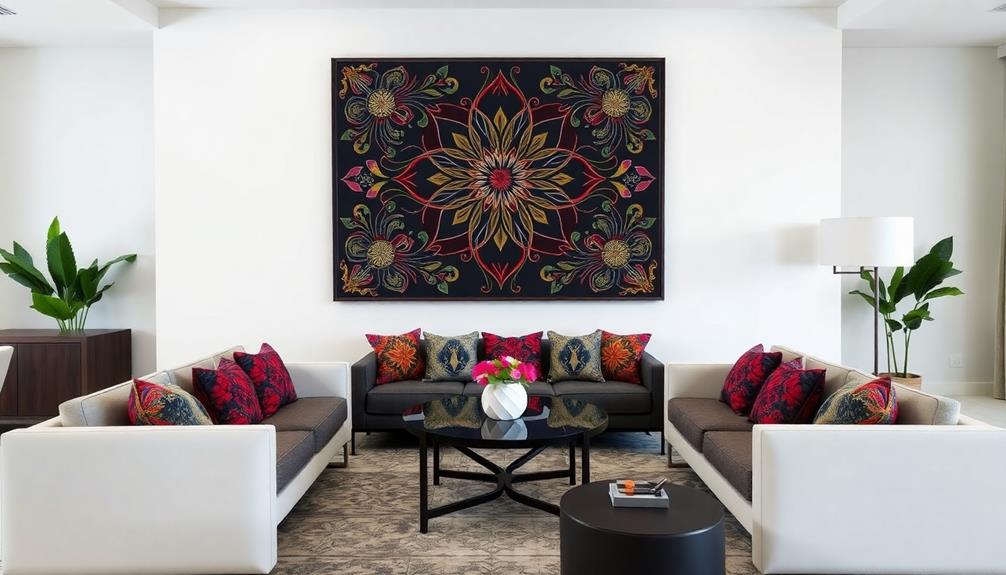
Batik embodies the soul of Indonesian culture, offering a vibrant glimpse into the nation's history and traditions. This exquisite Indonesian textile showcases intricate patterns that tell stories of nature, mythology, and local heritage.
When you explore traditional batik, you're not just admiring fabric; you're witnessing centuries of artistry and craftsmanship rooted in Indonesia's identity. These patterns often draw inspiration from traditional artistry, with designs that echo the rich cultural narratives found in various Indonesian decor masks.
The batik-making process is a labor of love, where artisans apply molten wax using a canting tool to create unique designs. Each piece reflects a deep connection to regional influences, with styles like batik Solo, batik Yogyakarta, and batik Pekalongan standing out with distinct colors and motifs.
These patterns serve as a visual language, conveying cultural meanings and personal narratives. Recognized by UNESCO as an Intangible Cultural Heritage, batik holds a significant place in the hearts of Indonesians.
It's more than just a textile; it's a symbol of pride and unity. As you embrace the essence of batik in modern spaces, you're not only celebrating its beauty but also supporting local artisans and preserving an essential part of Indonesian heritage for future generations.
Historical Significance of Batik
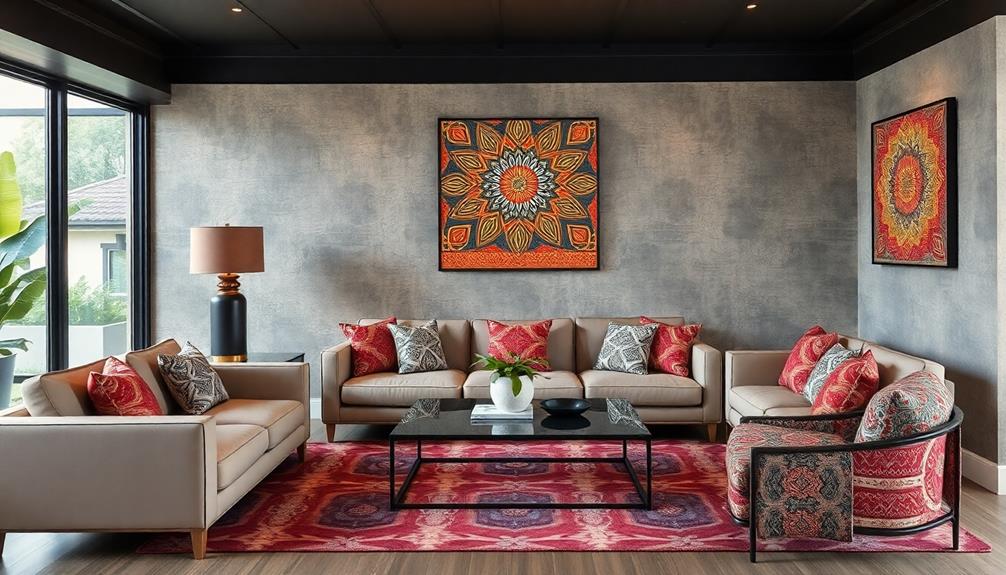
When you explore the historical significance of batik, you uncover its ancient roots in Java and the craftsmanship that has evolved over centuries.
This art form not only served as a symbol of royalty and social status but also became an essential part of cultural identity for Indonesians.
Additionally, batik patterns are often featured in modern decor, bridging the gap between contemporary and traditional aesthetics, much like the Face Indonesian Decor Mask that represents rich cultural heritage.
Understanding these aspects deepens your appreciation for batik's role in society and its enduring legacy.
Ancient Craft Origins
The intricate art of batik boasts a rich history that traces back to Java in the 6th or 7th century, likely drawing inspiration from techniques introduced by Indian or Sri Lankan artisans.
This ancient craft evolved into a crucial part of the batik tradition, reflecting the vibrant culture of the ancient Javanese. Batik patterns often resonate with the cultural significance of housing in Indonesia, intertwining artistic expression with regional identity and heritage.
Batik production became an essential element in royal ceremonies, emphasizing its importance in the Javanese royal courts. While it didn't gain widespread attention until after the 16th century, its unique patterns and colors were influenced by trade interactions with the Melayu Kingdom.
Here are four key aspects of batik's historical significance:
- Cultural Symbol: Batik represents the identity and heritage of the Indonesian people.
- Artistic Techniques: The craftsmanship involves intricate wax-resist dyeing methods.
- UNESCO Recognition: In 2009, batik was designated as an Intangible Heritage of Humanity.
- Diverse Styles: Different regions contributed to the evolution of batik styles, showcasing a rich variety of designs.
Through these elements, you can appreciate the depth and beauty of batik's origins and its lasting legacy.
Royalty and Status
As you explore the historical significance of batik, you'll find that its origins reflect a deep connection to royalty and status in Javanese culture. Dating back to the 6th century, Javanese batik was initially reserved for nobility, symbolizing wealth and authority. Specific patterns were designated for royalty and high-ranking individuals, with certain intricate designs used exclusively during royal ceremonies and rituals.
This rich cultural heritage is mirrored in other traditional crafts, such as Indonesian decor masks, which also serve as a demonstration of the artistry of the region cultural storytelling aspect.
The complexity of these motifs wasn't just for decoration; they indicated social hierarchy within Javanese culture, with different designs signifying various ranks. By the 17th century, batik became integral to the royal courts of Java, showcasing the region's rich artistry and cultural significance.
The batik industry flourished as these designs evolved, cementing their place in everyday life. Government initiatives formalized the practice, mandating civil servants to wear batik attire, further reinforcing its association with authority and respect.
Today, while batik transcends its original royal status, the historical ties to royalty remind us of its profound cultural heritage. As you appreciate modern interpretations, remember the intricate journey batik has taken through time, blending tradition with contemporary aesthetics.
Cultural Identity Symbol
Batik serves as a vibrant symbol of cultural identity in Indonesia, deeply intertwined with the nation's historical narratives and traditions.
With roots tracing back to the 6th century, Indonesian batik has evolved into a crucial representation of national pride and artistic expression. Recognized as a UNESCO Intangible Cultural Heritage in 2009, its significance extends beyond aesthetics. The colorful designs and intricate patterns not only enhance modern spaces but also connect them to traditional values, making batik a versatile choice for decor in contemporary homes, including Indonesian Decorative Pillows.
Here are four key aspects of batik's cultural identity:
- Historical Significance: Originally reserved for nobility, batik was used in royal ceremonies, marking wealth and heritage.
- Symbolic Meanings: The intricate textile patterns often convey messages related to social status, regional identity, and life events, especially within Javanese culture.
- Ceremonial Role: Various motifs are associated with specific ceremonies and rituals, reinforcing their narrative role in Indonesia's rich cultural history.
- Artistic Expression: Each batik piece is a unique work of art, showcasing the creativity and skill of its maker, and reflecting the diverse cultural influences across Indonesia.
Through these elements, batik remains a profound symbol of cultural identity, celebrating Indonesia's heritage and artistry.
Craftsmanship and Techniques

Craftsmanship in batik is a meticulous dance of artistry and technique, where skilled artisans breathe life into fabric through a labor-intensive wax-resist dyeing process. You'll find that each piece showcases intricate batik patterns, meticulously drawn by hand with a canting tool filled with molten wax. This tool, a small copper container with a bamboo handle, allows for precise wax application, enabling artisans to create detailed designs.
The use of natural materials like cotton and silk is essential, as these fabrics' high thread count maintains the intricacy of the patterns. Artisans often rely on a special wax mixture, combining beeswax for flexibility and paraffin for brittleness, sourced from Indonesian islands like Timor and Sumatra.
To better understand the craftsmanship behind batik, here's a quick overview:
| Technique | Description | Materials Used |
|---|---|---|
| Wax-Resist Dyeing | Labor-intensive process using wax and dye | Natural cotton, silk |
| Canting Tool | Enables precise wax application for details | Copper, bamboo |
| Cap Technique | Introduced for mass production, preserving art | Beeswax, paraffin |
Through these techniques, batik remains an enduring symbol of Indonesian culture.
Modern Applications in Design
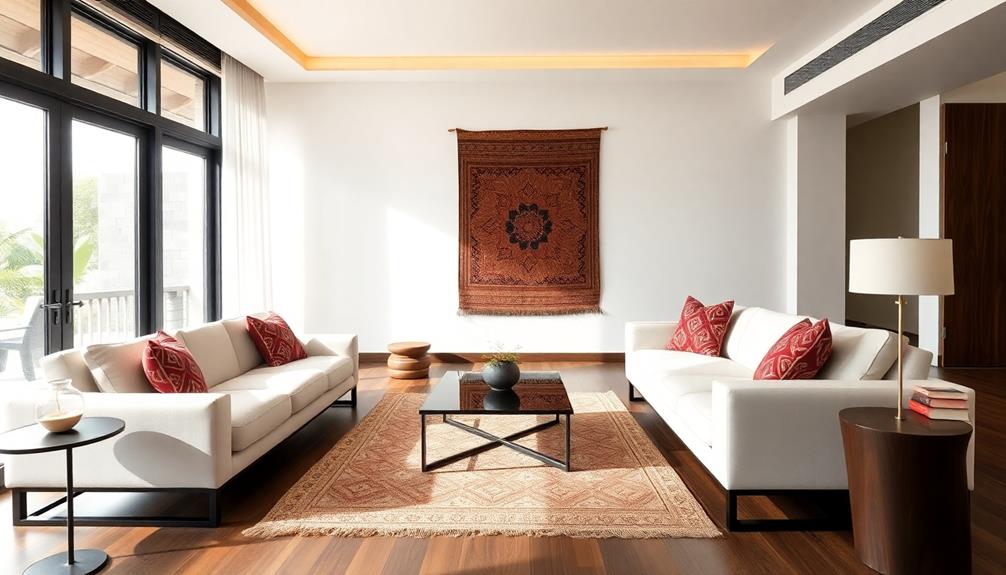
Modern Applications in Design
You'll see batik's vibrant patterns making their way into both fashion and interior design, creating a fresh fusion of tradition and modernity.
Incorporating elements of traditional Indonesian style home decor, designers are collaborating to showcase batik in everything from chic loungewear to stylish home accessories, appealing to today's aesthetic sensibilities.
This integration not only honors cultural heritage but also sets new trends that resonate with contemporary consumers.
Batik in Interior Design
The allure of batik patterns is transforming modern interior design, adding a rich cultural dimension to contemporary spaces.
You'll find that batik textiles aren't just historical artifacts; they're becoming essential elements in today's homes. Designers are creatively adapting traditional craftsmanship to produce batik-inspired pieces that blend seamlessly with modern aesthetics.
This integration of traditional motifs and vibrant colors from Indonesian culture enhances the visual appeal of interiors, creating an inviting atmosphere that resonates with warmth and authenticity, such as in Indonesian Wedding Decor: Must-Have Ideas.
Here are four ways batik is making its mark in interior design:
- Wall Coverings: Batik-inspired wallpaper brings depth and character to your walls, making a bold statement.
- Upholstery: Sofas and chairs adorned with batik textiles offer a unique touch while maintaining comfort and style.
- Decorative Cushions: Add batik-patterned cushions to your living space for a splash of color and cultural flair.
- Table Linens: Incorporating batik into tablecloths and napkins elevates your dining experience, showcasing artisanal craftsmanship.
Fashion Collaborations and Trends
Embracing the fusion of tradition and innovation, contemporary fashion is witnessing a vibrant resurgence of batik as designers craft unique pieces that honor cultural heritage while appealing to modern sensibilities.
Designers like Tan Sheau Yun are seamlessly integrating batik into contemporary fashion, creating masterpieces that blend traditional patterns with modern fabrics like denim. This cultural fusion not only enhances the aesthetic but also revitalizes traditional craftsmanship, much like the expert consultation for tropical living spaces offered by Mahallati Interior.
Brands such as Nost are addressing the rise in consumer demand for unique batik pieces by focusing on sustainable loungewear and homeware, ensuring that their products are non-mass-produced and respect the art of batik.
The "Batik Kita: Dressing in Port Cities" exhibition showcases 100 masterpieces, highlighting both historical and modern designs, which inspire new interpretations of this rich textile.
Collaborative initiatives with institutions like the Nanyang Academy of Fine Arts encourage young designers to reinterpret traditional batik fabrics, bringing them into modern menswear.
These modern adaptations reflect a growing vibrancy in the batik fashion marketplace, signaling a shift towards appreciating the artistry and uniqueness of batik as a masterpiece in contemporary design.
Cultural Impact and Recognition
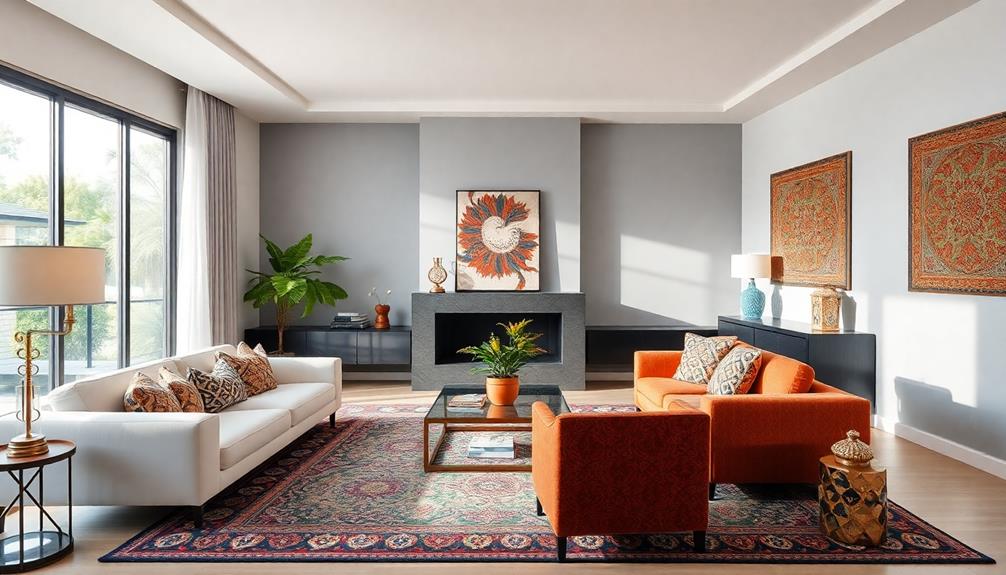
Throughout the years, batik has gained significant recognition for its cultural importance, particularly after being designated as a UNESCO Intangible Cultural Heritage in 2009. This acknowledgment emphasizes batik's cultural significance and the need for its preservation globally.
As you explore its impact, you'll notice several key elements: Balinese interior design often incorporates traditional motifs like batik, creating a unique blend of modern aesthetics with cultural artistry that enhances any space. This fusion highlights the significance of natural materials and craftsmanship in celebrating Indonesian heritage.
- National Batik Day is celebrated every October 2, raising awareness and appreciation for batik as a crucial aspect of Indonesian culture.
- The Indonesian batik industry saw notable sales growth, from Rp 2.5 trillion in 2006 to Rp 3.9 trillion in 2010, highlighting its expanding economic influence.
- Initiatives like international exhibitions and collaborations have increased batik's visibility, influencing fashion trends in neighboring countries, such as Singapore and Malaysia.
- The interplay of batik with contemporary fashion has allowed traditional craftsmanship to resonate within modern design, enhancing its relevance in global markets.
Understanding batik's role as an Oral and Intangible Heritage helps you appreciate its artistry and cultural depth.
Batik in Contemporary Fashion
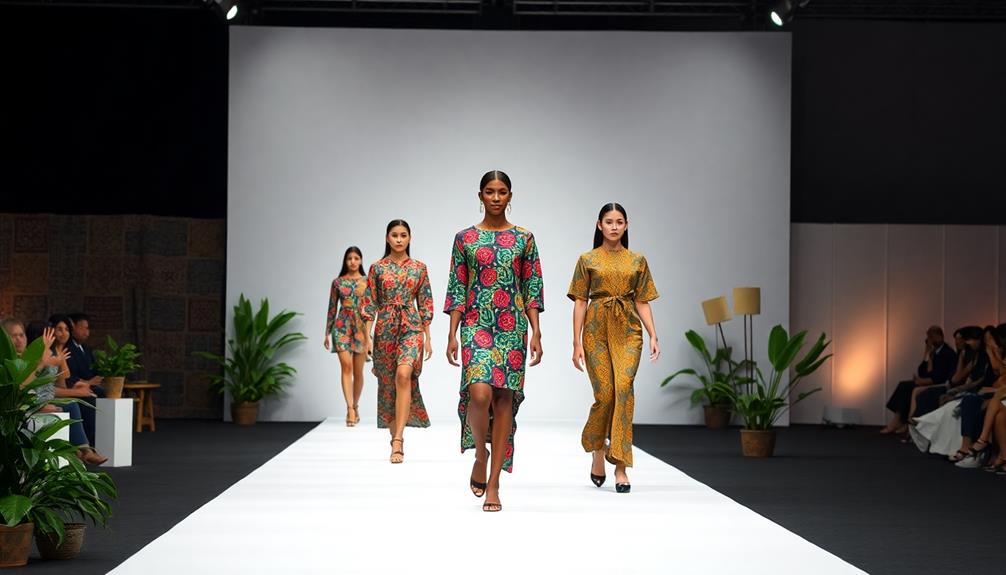
MY ARTICLE SUBHEADING CONTENT:
Batik finds a fresh expression in contemporary fashion as designers seamlessly blend traditional motifs with modern silhouettes. You'll notice how batik is now featured in various styles, from casual loungewear to formal dresses, making it a versatile choice for all occasions.
This fusion mirrors the principles found in tropical contemporary house design, which combines modern elements with natural surroundings. Think of unique pieces that combine batik with denim, like stylish cheongsams, which cater to the modern consumer needs while celebrating cultural heritage.
Brands like Nost are leading the way in sustainable, artisanal production, ensuring that these handcrafted fashion pieces respect the traditional techniques that make batik special. This growing market reflects a shift toward a more mindful approach to fashion, emphasizing originality and craftsmanship.
Collaborations between young designers and traditional batik producers are sparking innovation, as they reinterpret batik fabrics for contemporary menswear, showcasing a dynamic fusion of old and new.
As you explore contemporary fashion, you'll find that the increasing demand for unique batik pieces highlights its evolving relevance and cultural impact. So, embrace the intricate beauty of batik as it continues to thrive and inspire in today's fashion landscape.
Integrating Batik Into Interiors

Integrating batik into your interiors can transform a space, bringing a vibrant cultural richness that stands out. This traditional fabric has become a popular choice for home decor, seamlessly blending with modern aesthetics while celebrating Indonesia's cultural heritage.
Here are some ways you can incorporate batik into your home:
- Upholstery: Use batik fabric to reupholster furniture like chairs or sofas, adding a stunning focal point.
- Curtains: Opt for batik-patterned curtains to infuse your space with color and texture while maintaining privacy.
- Wall Art: Frame batik pieces or create a gallery wall showcasing various designs, turning your walls into a canvas of cultural expression.
- Soft Furnishings: Incorporate batik through throw pillows and table runners, offering a touch of elegance and artistry.
Educational Initiatives and Workshops

Several educational initiatives and workshops have emerged to promote and preserve the art of batik-making, inviting participants to engage directly with this rich tradition. These programs not only teach traditional batik-making skills but also encourage community engagement and support for local artisans.
Here's a look at some key aspects of these initiatives:
| Initiative Type | Description | Impact on Community |
|---|---|---|
| Workshops | Hands-on experiences with experienced artisans | Skill enhancement for participants |
| Online Resources | YouTube tutorials making techniques accessible | Broader audience reach |
| Community Programs | Revitalizing local batik industries | Sustainable practices in production |
| Awards | Golden Crane Creativity award for instructional resources | Recognition of educational contributions |
| Artisan Collaborations | Partnerships with local artisans for authenticity | Strengthening community ties |
These workshops often focus on intricate wax-resist dyeing techniques, allowing you to learn directly from experts. By participating, you'll not only gain valuable skills but also contribute to the preservation of batik traditions for future generations, ensuring this vibrant art form continues to thrive.
Future of Batik Heritage
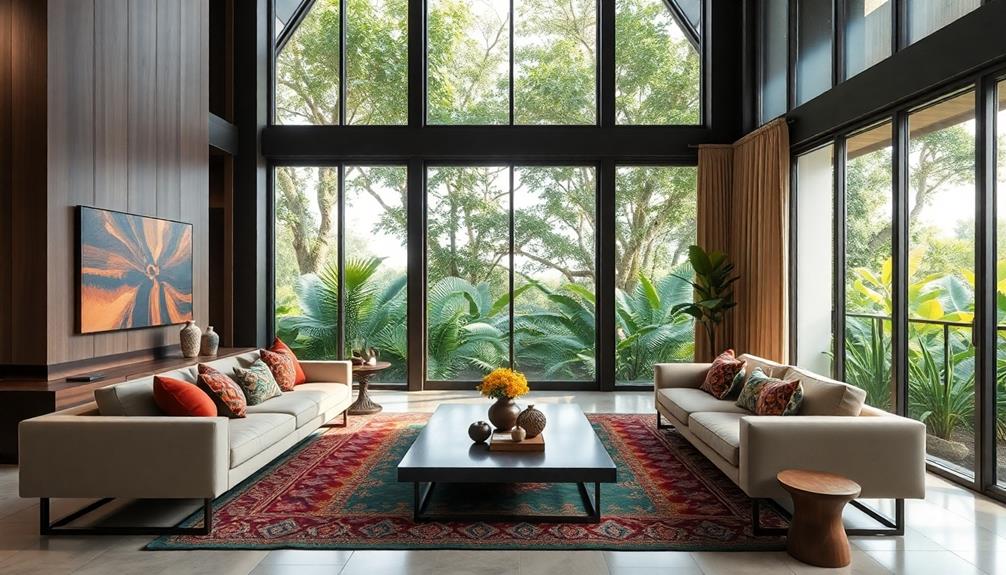
The future of Indonesia's batik heritage looks promising, thanks to innovative initiatives designed to engage younger generations.
With the rise of technology and creative collaborations, you can play an essential role in preserving this cultural treasure. Here are four key elements to evaluate:
- iWareBatik App: This app enhances your understanding of batik's cultural significance, making learning engaging and interactive.
- Educational Initiatives: Workshops and online resources promote batik-making skills, ensuring you can appreciate and create this art form.
- Collaboration with Artisans: Working alongside local artisans and designers helps revitalize traditional practices, integrating them into contemporary fashion and lifestyle.
- UNESCO Recognition: Since batik was recognized as an Intangible Cultural Heritage in 2009, global interest has surged, supporting its preservation and promotion.
Frequently Asked Questions
What Is the Famous Fabric Design of Indonesia?
The famous fabric design of Indonesia is batik. You'll find intricate patterns that reflect cultural significance and social status. This unique fabric, often made from cotton or silk, showcases exceptional craftsmanship and artistry.
What Does Batik Mean in Indonesian?
Batik means "to write" in Indonesian, derived from Javanese words "amba" and "titik." This traditional cloth-making technique highlights your culture's artistry, using wax-resist dyeing to create intricate and meaningful designs on fabric.
What Is a Batik Design?
A batik design's a mesmerizing tapestry of intricate patterns, where molten wax dances upon fabric, preserving colors while telling vibrant stories. Each motif whispers traditions, reflecting cultural heritage, social status, and regional pride in every stitch.
Why Is Batik Unique?
Batik's unique because it combines intricate designs with a wax-resist dyeing technique, making each piece a one-of-a-kind creation. You'll appreciate its cultural significance and the skilled craftsmanship that goes into every fabric.
Conclusion
So, next time you decorate your home or choose an outfit, why not drape yourself in a tapestry of tradition? After all, who needs bland decor when you can rock a living history lesson? Imagine your friends' faces as you strut in batik, blending the elegance of the past with your modern flair. It's like hosting a cultural gala in your closet—who knew heritage could be so fashionable? Embrace the chaos of colors and patterns; it's practically art!



